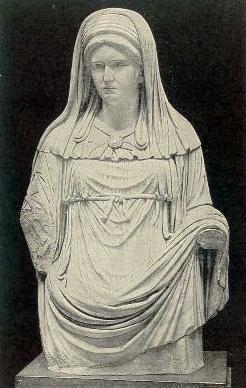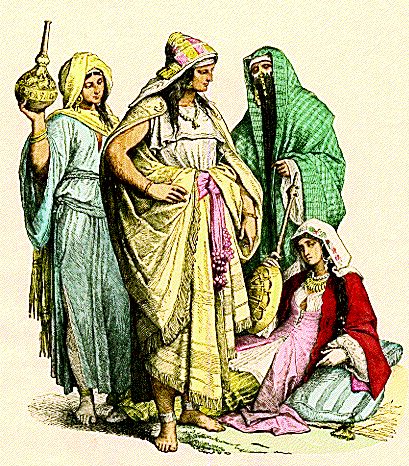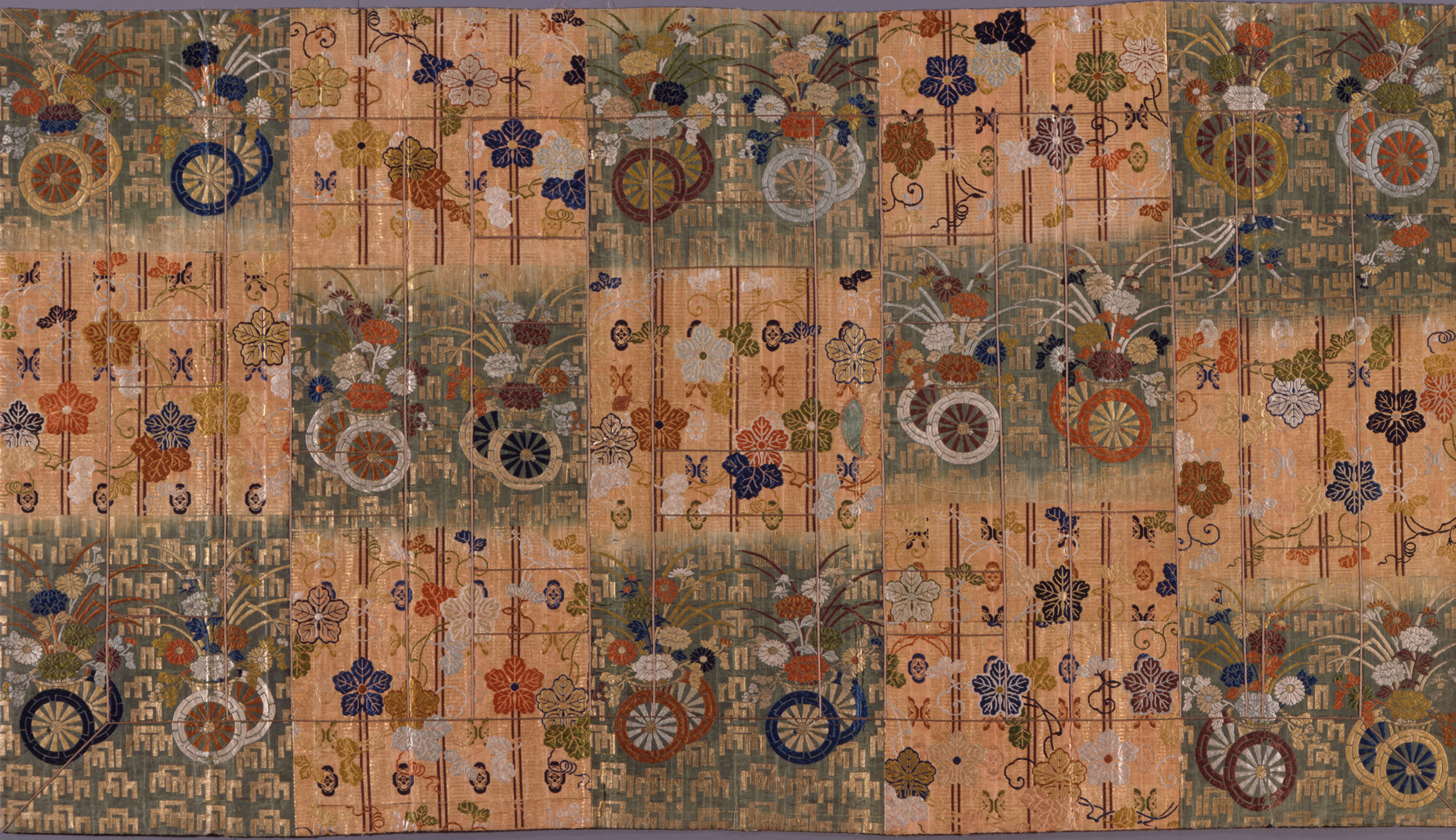|
Wimple
A wimple is a medieval form of female headcovering, formed of a large piece of cloth worn draped around the neck and chin, covering the top of the head; it was usually made from white linen or silk. Its use developed in early medieval Europe; in medieval Christianity it was unseemly for a married woman to show her hair. A wimple might be elaborately starched, creased and folded in prescribed ways. Later elaborate versions were supported on wire or wicker framing, such as the cornette. Italian women abandoned their head coverings in the 15th century or replaced them with transparent gauze, showing their braids. Elaborate braiding and elaborately laundered clothes demonstrated status, because such grooming was performed by others. Today a plain wimple is worn by the nuns of certain orders who retain a traditional habit. In literature The Wife of Bath and the Prioress are depicted wearing wimples in the ''Canterbury Tales'' of Geoffrey Chaucer (1400). The King James Version ... [...More Info...] [...Related Items...] OR: [Wikipedia] [Google] [Baidu] |
Veil
A veil is an article of clothing or hanging cloth that is intended to cover some part of the human head, head or face, or an object of some significance. Veiling has a long history in European, Asian, and African societies. The practice has been prominent in different forms in Judaism, Christianity, and Islam. The practice of veiling is especially associated with women and sacred objects, though in some cultures, it is men, rather than women, who are expected to wear a veil. Besides its enduring religious significance, veiling continues to play a role in some modern secular contexts, such as wedding customs. History Antiquity Elite women in ancient Mesopotamia and in the Rise of Macedon, Macedonian and Persian Empire, Persian empires wore the veil as a sign of respectability and high status. The earliest attested reference to veiling is found a Middle Assyrian Empire, Middle Assyrian law code dating from between 1400 and 1100 BC. Assyria had explicit sumptuary laws detailin ... [...More Info...] [...Related Items...] OR: [Wikipedia] [Google] [Baidu] |
Headscarf
A headscarf is a scarf covering most or all of the top of a person's, usually women's, hair and head, leaving the face uncovered. A headscarf is formed of a triangular cloth or a square cloth folded into a triangle, with which the head is covered. Purposes Headscarves may be worn for a variety of purposes, such as protection of the head or hair from rain, wind, dirt, cold, warmth, for sanitation, for fashion, recognition or social distinction; with religious significance, to hide baldness, out of modesty, or other forms of social convention. Headscarves are now mainly worn for practical, cultural or religious reasons. Until the latter 20th century, headscarves were commonly worn by women in many parts of Europe, Southwestern Asia, North Africa, and the Americas, as well as some other parts of the world. In recent decades, headscarves, like hats, have fallen out of favor in Western culture. They are still, though, common in many rural areas of Eastern Europe as well as many ... [...More Info...] [...Related Items...] OR: [Wikipedia] [Google] [Baidu] |
The Scarlet Witch
The Scarlet Witch is a fictional character appearing in American comic books published by Marvel Comics. Created by writer Stan Lee and artist Jack Kirby, the character first appeared in The X-Men #4 in March 1964, in the Silver Age of Comic Books. Originally described as having the power to alter probability, the Scarlet Witch evolved into a powerful Sorceress (fantasy), sorceress by the 1980s. Over time, she has occasionally tapped into immense Magical forest, magical forces, allowing her to alter reality itself. She is widely recognized as one of Marvel’s most powerful heroes. The Scarlet Witch, an alter ego of Wanda Django Maximoff, was first introduced as a reluctant supervillain alongside her twin brother, Quicksilver (Marvel Comics), Quicksilver, both founding members of the Brotherhood of Mutants, Brotherhood of Evil Mutants. A year later, she joined the Avengers (comics), Avengers and became a longtime member of various teams like the West Coast Avengers and Force Wor ... [...More Info...] [...Related Items...] OR: [Wikipedia] [Google] [Baidu] |
Christian Headcovering
Christian head covering, also known as Christian veiling, is the traditional practice of women covering their head in a variety of Christian denominations. Some Christian women wear the head covering in public worship and during private prayer at home, while others (esp. Conservative Anabaptists) believe women should wear head coverings at all times. Among Catholic, Oriental and Eastern Orthodox Churches, certain theologians likewise teach that it is "expected of all women to be covered not only during liturgical periods of prayer, but at all times, for this was their honor and sign of authority given by our Lord", while others have held that headcovering should at least be done during prayer and worship. Genesis 24:65 records the veil as a feminine emblem of modesty. Manuals of early Christianity, including the ''Didascalia Apostolorum'' and ''Pædagogus'', instructed that a headcovering must be worn by women during prayer and worship as well as when outside the home. When ... [...More Info...] [...Related Items...] OR: [Wikipedia] [Google] [Baidu] |
Hijab
Hijab (, ) refers to head coverings worn by Women in Islam, Muslim women. Similar to the mitpaḥat/tichel or Snood (headgear), snood worn by religious married Jewish women, certain Christian head covering, headcoverings worn by some Christian women, such as the hanging veil, apostolnik and Kapp (headcovering), kapp, and the dupatta favored by many Hindus, Hindu and Sikhs, Sikh women, the hijab comes in various forms. The term describes a scarf that is wrapped around the head, covering the hair, neck, and ears while leaving the face visible. The use of the hijab has grown globally since the 1970s, with many Muslims viewing it as a symbol of modesty and faith; it is also worn as a form of adornment. There is consensus among Islamic religious scholars that covering the head is required. In practice, most Muslim women choose to wear it. The term was originally used to denote a partition and was sometimes used for Haya (Islam), Islamic rules of modesty. In the verses of the Qur'an, ... [...More Info...] [...Related Items...] OR: [Wikipedia] [Google] [Baidu] |
Guimpe
The guimpe (from the French ''guimpe)'' was a garment which developed in medieval Western Europe. It was a silk or linen kerchief, sometimes sheer, sometimes starched, which covered the neck and shoulders of the wearer, sometimes the entire chest as well. It was worn as part of the apparel of a woman of means, both to show social standing — due to the added upkeep it required — and to demonstrate the woman's sense of modesty. Among nuns it was worn in combination with a coif and wimple. As women in Renaissance Italy began to leave their heads uncovered, and to expose their shoulders, the guimpe slowly fell into disuse. Its use continued solely in monasteries, as part of a nun's religious habit. As women's religious orders began to adopt contemporary attire, it has largely disappeared from these circles as well. From the early nineteenth century onwards, the term guimpe also described a form of short under-blouse or chemisette which was worn under a pinafore or low cut d ... [...More Info...] [...Related Items...] OR: [Wikipedia] [Google] [Baidu] |
Religious Habit
A religious habit is a distinctive set of clothing worn by members of a religious order. Traditionally, some plain garb recognizable as a religious habit has also been worn by those leading the religious Hermit, eremitic and Anchorite, anchoritic life, although in their case without conformity to a particular uniform style. Uniformity and distinctiveness by order often evolved and changed over time. Interpretation of terms for clothes in religious rules could change over centuries. Furthermore, every time new communities gained importance in a cultural area the need for visual separation increased for new as well as old communities. Thus, modern habits are rooted in historic forms, but do not necessarily resemble them in cut, color, material, detail or use. In Christian monasticism, Christian monastic orders of the Catholic church, Catholic, Lutheranism, Lutheran and Anglicanism, Anglican Churches, the habit often consists of a tunic covered by a scapular and cowl, with a hood ... [...More Info...] [...Related Items...] OR: [Wikipedia] [Google] [Baidu] |
Cornette
A cornette is a piece of headwear for religious sisters. It is essentially a type of wimple consisting of a large starched piece of white cloth that is folded upward in such a way as to create the resemblance of horns () on the wearer's head. Initially, the cornette was fashionable for some Parisian ladies around 1800, wearing ones made of muslin or gauze and richly ornamented with lace. Use by the Daughters of Charity The cornette was retained as a distinctive piece of clothing into modern times by the Daughters of Charity, a society of apostolic life founded by St. Vincent de Paul in the mid-17th century. The founder wanted to have a community of women that tended to the sick and poor, and were not required to remain in the papal enclosure as nuns do, resemble ordinary middle-class women as much as possible in their clothing, including the wearing of the cornette. After the cornette generally fell into disuse, it became a distinctive feature of the Daughters of Charity, ... [...More Info...] [...Related Items...] OR: [Wikipedia] [Google] [Baidu] |
Book Of Isaiah
The Book of Isaiah ( ) is the first of the Latter Prophets in the Hebrew Bible and the first of the Major Prophets in the Christian Old Testament. It is identified by a superscription as the words of the 8th-century BC prophet Isaiah ben Amoz, but there is evidence that much of it was composed during the Babylonian captivity and later. Johann Christoph Döderlein suggested in 1775 that the book contained the works of two prophets separated by more than a century, and Bernhard Duhm originated the view, held as a consensus through most of the 20th century, that the book comprises three separate collections of oracles: Proto-Isaiah ( chapters 1– 39), containing the words of the 8th-century BC prophet Isaiah; Deutero-Isaiah, or "the Book of Consolation", ( chapters 40– 55), the work of an anonymous 6th-century BCE author writing during the Exile; and Trito-Isaiah ( chapters 56– 66), composed after the return from Exile. Isaiah 1– 33 promises judgment and restoration for ... [...More Info...] [...Related Items...] OR: [Wikipedia] [Google] [Baidu] |
Hebrew Language
Hebrew (; ''ʿÎbrit'') is a Northwest Semitic language within the Afroasiatic language family. A regional dialect of the Canaanite languages, it was natively spoken by the Israelites and remained in regular use as a first language until after 200 CE and as the liturgical language of Judaism (since the Second Temple period) and Samaritanism. The language was revived as a spoken language in the 19th century, and is the only successful large-scale example of linguistic revival. It is the only Canaanite language, as well as one of only two Northwest Semitic languages, with the other being Aramaic, still spoken today. The earliest examples of written Paleo-Hebrew date back to the 10th century BCE. Nearly all of the Hebrew Bible is written in Biblical Hebrew, with much of its present form in the dialect that scholars believe flourished around the 6th century BCE, during the time of the Babylonian captivity. For this reason, Hebrew has been referred to by Jews as '' ... [...More Info...] [...Related Items...] OR: [Wikipedia] [Google] [Baidu] |
Kerchief
A kerchief (from the Old French ''couvre-chef'', "cover head"), also known as a bandana or bandanna, is a triangular or square piece of cloth tied around the Human head, head, face, or neck for protective or decorative purposes. The popularity of ''head kerchiefs'' may vary by culture or religion, often being used as a Christian headcovering by men and women of the Anabaptist, Eastern Orthodox, and Plymouth Brethren denominations, as well as by some Orthodox Jewish and Muslim men and women and is also considered a hat. The ''neckerchief'' and ''handkerchief'' are related items. Types Bandana A bandana or bandanna (from Hindi and Urdu, ultimately from Sanskrit बन्धन or bandhana, "a bond") is a type of large, usually colourful kerchief, originating from the Indian subcontinent, often worn on the head or around the neck of a person. Bandanas are frequently printed in a paisley pattern and are most often used to hold hair back, either as a fashionable head accessory or fo ... [...More Info...] [...Related Items...] OR: [Wikipedia] [Google] [Baidu] |







